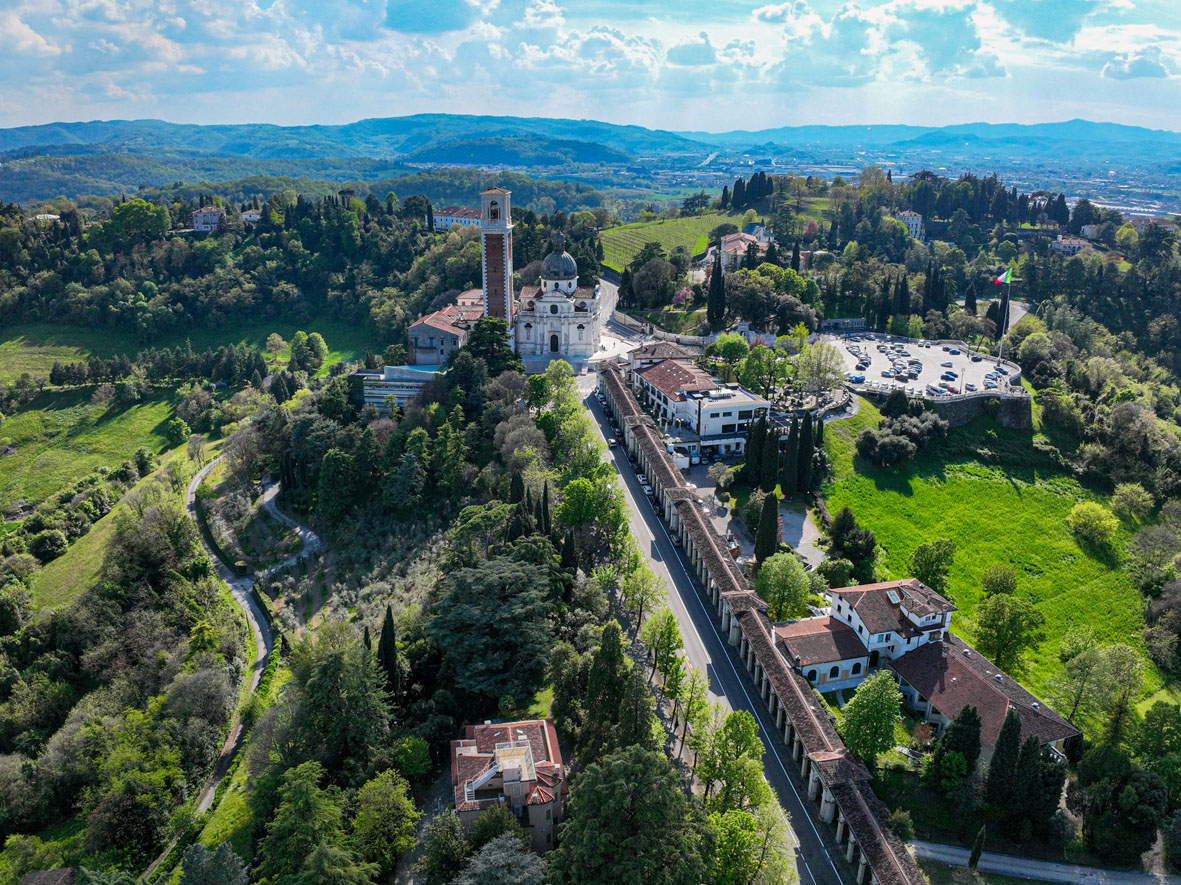
Have you ever dreamed of immersing yourself in the magnificence of Vicenza and in particular Renaissance Vicenza?
There are two masterpieces in Vicenza, a jewel of a city, that can be admired through an itinerary that promises to be an exciting journey into beauty and art.
In this post, I will take you on a special tour that includes two recently restored Renaissance works, located in a city that interprets the Renaissance in a unique and sublime way.
Bellini and Veronese: two masterpieces in Vicenza
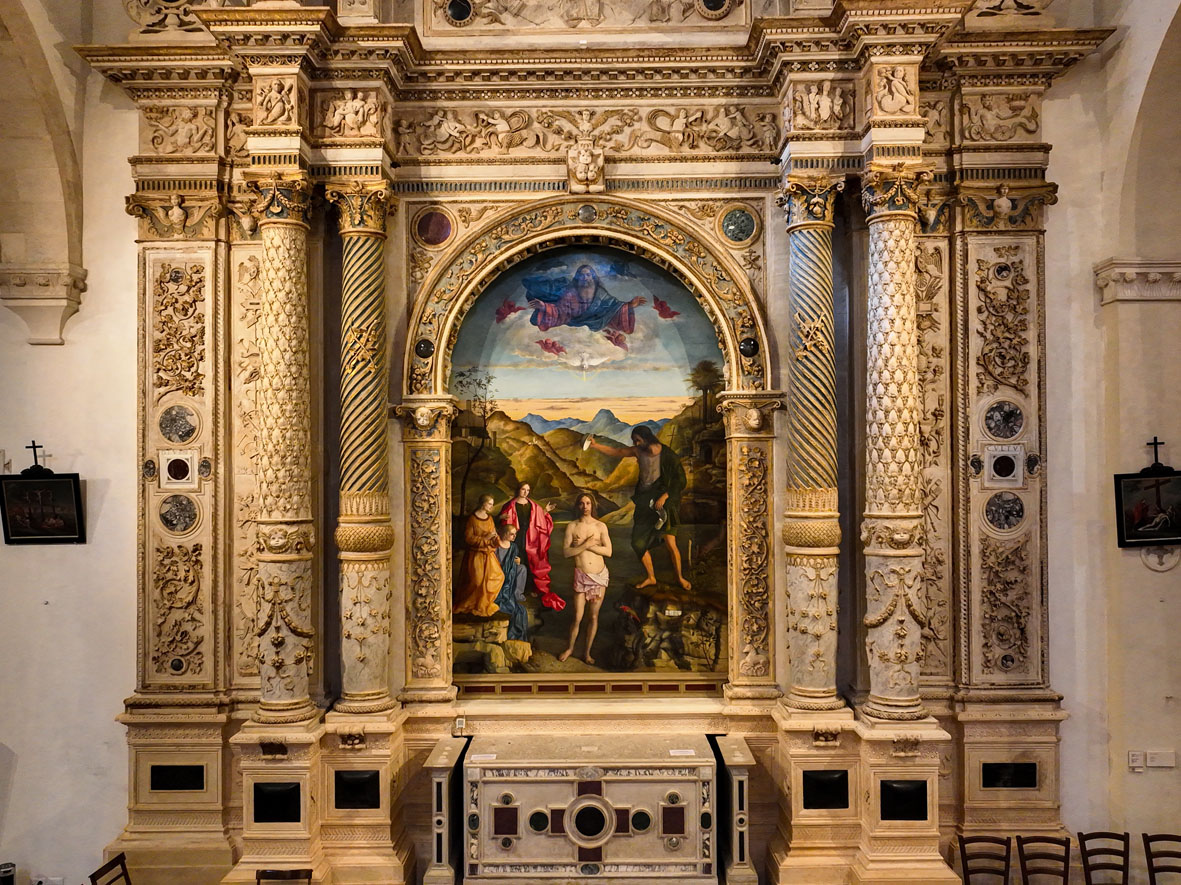
Giovanni Bellini, Battesimo di Cristo, Vicenza, Chiesa di Santa Corona
If you love to visit cities starting with the most beautiful works, then you must discover Vicenza by admiring two masterpieces by the great masters of the Italian Renaissance: Giovanni Bellini and Paolo Veronese.
Here is a cultural itinerary in Vicenza that offers not only pure beauty, but also a journey through curiosities and the hidden mysteries of art.
Vicenza presents itself as a stage celebrating the Renaissance. At the centre of this itinerary are two paintings that enchant for their beauty and profound significance: the ‘Baptism of Christ’ by Giovanni Bellini, located in the Church of Santa Corona, and the ‘Supper of St Gregory the Great’ by Paolo Veronese, housed in the Sanctuary of Monte Berico.
These works are not only expressions of artistic talent, but are also sources of hidden questions and symbols, typical of the Renaissance era.
THE BAPTISM OF CHRIST BY GIOVANNI BELLINI
This magnificent wooden work, created in the early 16th century, is a testimony to the genius of Bellini and his time. It is a representation rich in symbolism, illustrating the baptism of Christ with vivid colours and minute details. Interestingly, the presence of a red parrot, added later, adds a touch of mystery to the work.
The work was painted by Bellini on behalf of a rich textile merchant who wished to fulfil a vow he had made before embarking on a perilous journey to the Holy Land. A kind of sumptuous ex-voto that still leaves one stunned by its beauty.
The central point of the work is in the figure of Jesus, here in a submissive attitude to his father. John, the Baptist, sends down the water of the Jordan from a position that represents the central point between the dove of the Holy Spirit and the head of the Son. Assisting Faith, Hope, Charity described as beautiful angels and possibly portraits of the commissioner’s daughters. The colours of their robes are reflected in the water of the Jordan and reverberate on the white loincloth of the very blond Jesus.
The landscape, with the cave anticipating the tomb of the one who is baptised, combines memories of Palestine with the proximity of the Veneto hills. Attending the event is a red parrot, painted not by Giovanni Bellini but at a later time. At the time, in fact, that parrot was still an unknown species, yet its presence has questioned many scholars. Why include it in the painting? As a joke or to convey a precise message?
This is one of the mysteries of this masterpiece.
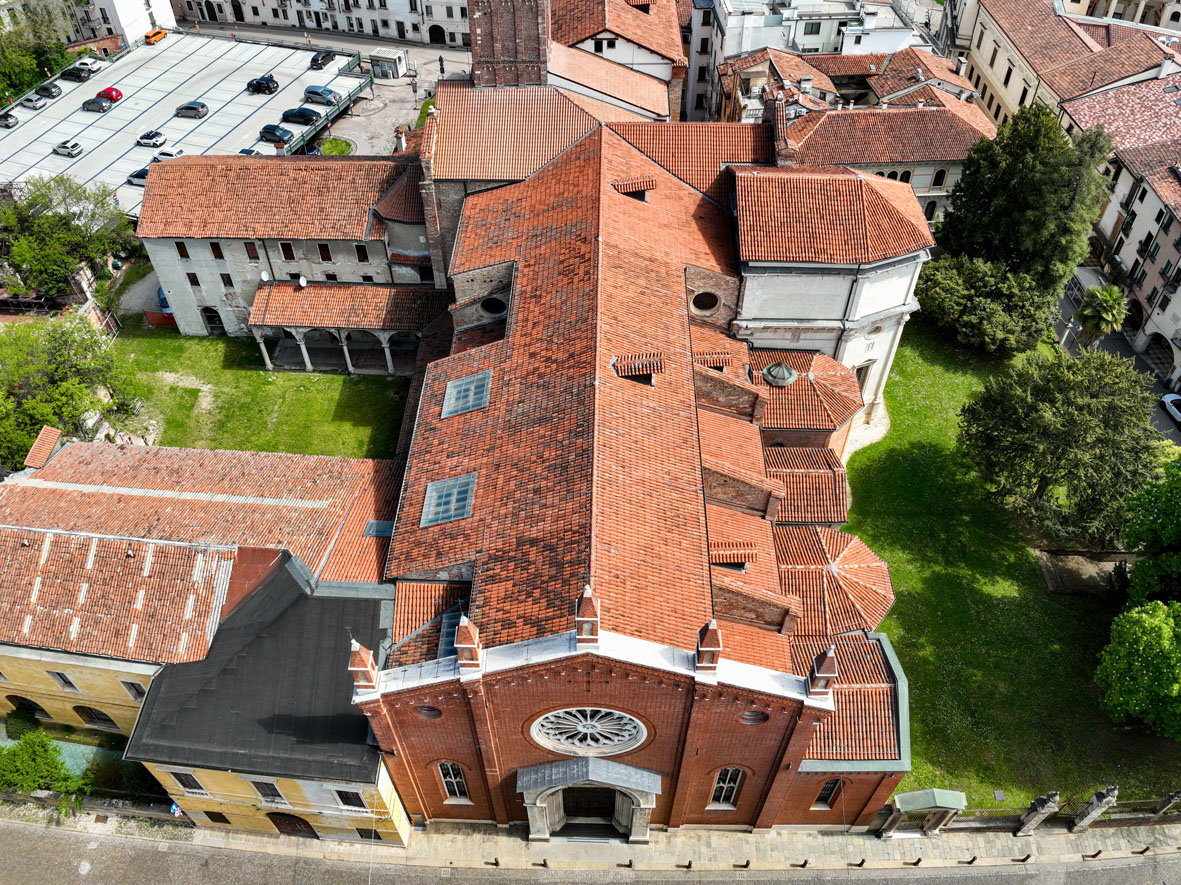
Vicenza, chiesa di Santa Corona
THE CHURCH HOUSING THE BAPTISM OF CHRIST BY GIOVANNI BELLINI
Bellini’s altarpiece with the Baptism of Christ fits into an altar of one of Vicenza’s oldest and most beautiful churches, the Dominican Santa Corona. Its name derives from the relic of the Holy Thorn donated by Louis IX King of France to the Bishop of Vicenza in 1261.
The Gothic interior, with a presbytery built by Lorenzo da Bologna in the second half of the 15th century, houses, in addition to the ‘Baptism’ by Giovanni Bellini, the ‘Adoration of the Magi’ by Paolo Veronese, the ‘Madonna of the Stars’ by Lorenzo Veneziano and Marcello Fogolino, the large altarpiece of the ‘Magdalene and Saints’ by Bartolomeo Montagna, and the ‘Madonna and Child with Saints’ by Giambattista Pittoni.
In the apse of the church, the carved and inlaid wooden choir by Pier Antonio dell’Abate is spectacular. Then there are the 15th-century frescoes by Michelino da Besozzo in the Thiene Chapel. Not to be missed is a visit to the Valmarana family chapel, the work of Andrea Palladio, who, according to tradition, was buried in this very church, before his remains were transported to the monumental tomb in the city cemetery.
Also worth noting before leaving is the spectacular High Altar and the imposing Cappella del Rosario.
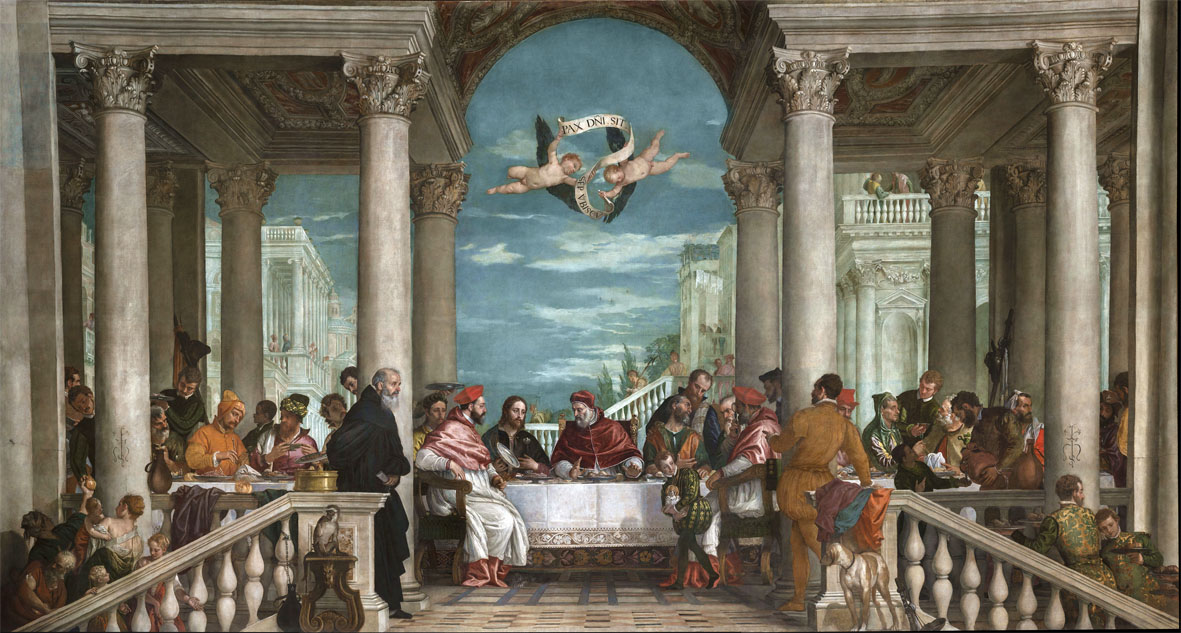
Paolo Veronese, La Cena di San Gregorio Magno, Vicenza, Santuario di Monte Berico. Post restauro @DeFina, Musei Civici di Vicenza.
THE SUPPER OF SAINT GREGORIO MAGNO BY PAOLO VERONESE
Located in the Basilica of Monte Berico, this extraordinary painting by Veronese is an example of grandeur both in size and artistry. It depicts an act of charity with a richness of detail and colour that leaves the visitor speechless. Interestingly, the work has undergone several vicissitudes over the years, including damage and restoration.
Veronese painted this grandiose work for the monks’ large refectory in 1572.
The ‘Supper of St. Gregory the Great’ is the only one of the great master’s three suppers to be visible in the place for which it was conceived. The other two are today kept in two important museums: one can be admired by visiting the Louvre Museum and the other is in the Pinacoteca di Brera.
The painting, of monumental dimensions (4.45 x 8.78 cm for a total of about 39 square metres), is considered one of the masterpieces of Veronese’s maturity. An elegant backdrop welcomes the 12 pilgrims who are the guests of honour at St. Gregory’s dinner. Tradition has it that the painter portrayed himself in the figure dressed in yellow, shown from behind, while the commissioner of the work, Friar Domenico Grana, the artist’s uncle, appears in a cassock to the left of the main scene.
In 1811, the work was stolen by Napoleon’s soldiers and sent to the Pinacoteca di Brera, where it remained for six years before being returned to Vicenza. On 10 June 1848, during the First War of Independence, Austro-Hungarian troops used their bayonets to cut the canvas into 32 pieces. It was the emperor himself who financed its restoration and returned it to the refectory of Monte Berico. From here, in 1916, he left for Florence to take it away from the nearby war front.
The Veronese Supper is not the only masterpiece of art kept in the Sanctuary run by the Servants of Mary and a constant pilgrimage destination.
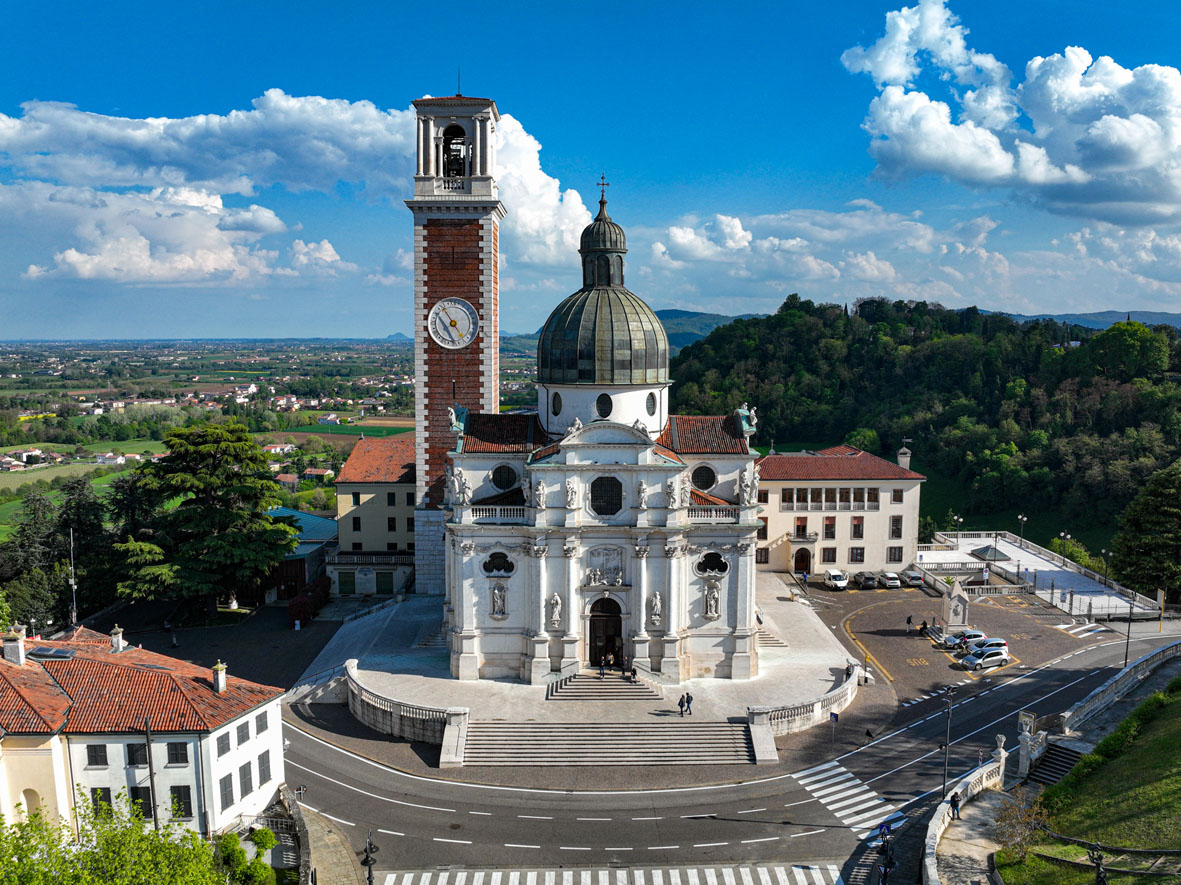
Vicenza, Santuario di Monte Berico
THE BASILICA HOUSING THE SUPPER OF SAINT GREGORY THE GREAT BY PAOLO VERONESE
The Basilica where Veronese’s work is located stands on the hill of ‘Monte Berico’, just over 140 metres high, and this building was erected on the spot where the Virgin appeared to Vincenza Pasini, a woman who was bringing food to her husband who was working on the hill. Our Lady promised the woman an end to the plague, which was scourging the city, and asked that a church be dedicated to her on that spot.
Already in 1428, within a few months, the first small late Gothic church and a small cenoby were built to house a religious community dedicated to welcoming pilgrims. Since then, the Sanctuary, joined to the city by a covered staircase, has been enlarged and renovated by several generations of architects, including Palladio himself.
RENAISSANCE ARCHITECTURE IN VICENZA
In addition to works of art, Vicenza is famous for its Renaissance architecture, in particular that of Andrea Palladio and Vincenzo Scamozzi. The city is a veritable open-air museum, with buildings and monuments representing the best of Renaissance architecture. Not to be missed are the Olympic Theatre, the Palladian Basilica, and Palladio’s famous Rotonda, which offer a comprehensive view of the city’s architectural heritage.
Vicenza offers a rich and immersive cultural experience, combining art, history and architecture in a unique itinerary. It is a destination that not only pleases the eyes, but also enriches the soul, inviting visitors to discover the mysteries and beauty of the Italian Renaissance. An unforgettable journey into the heart of art history awaits you. Are you ready to go?

